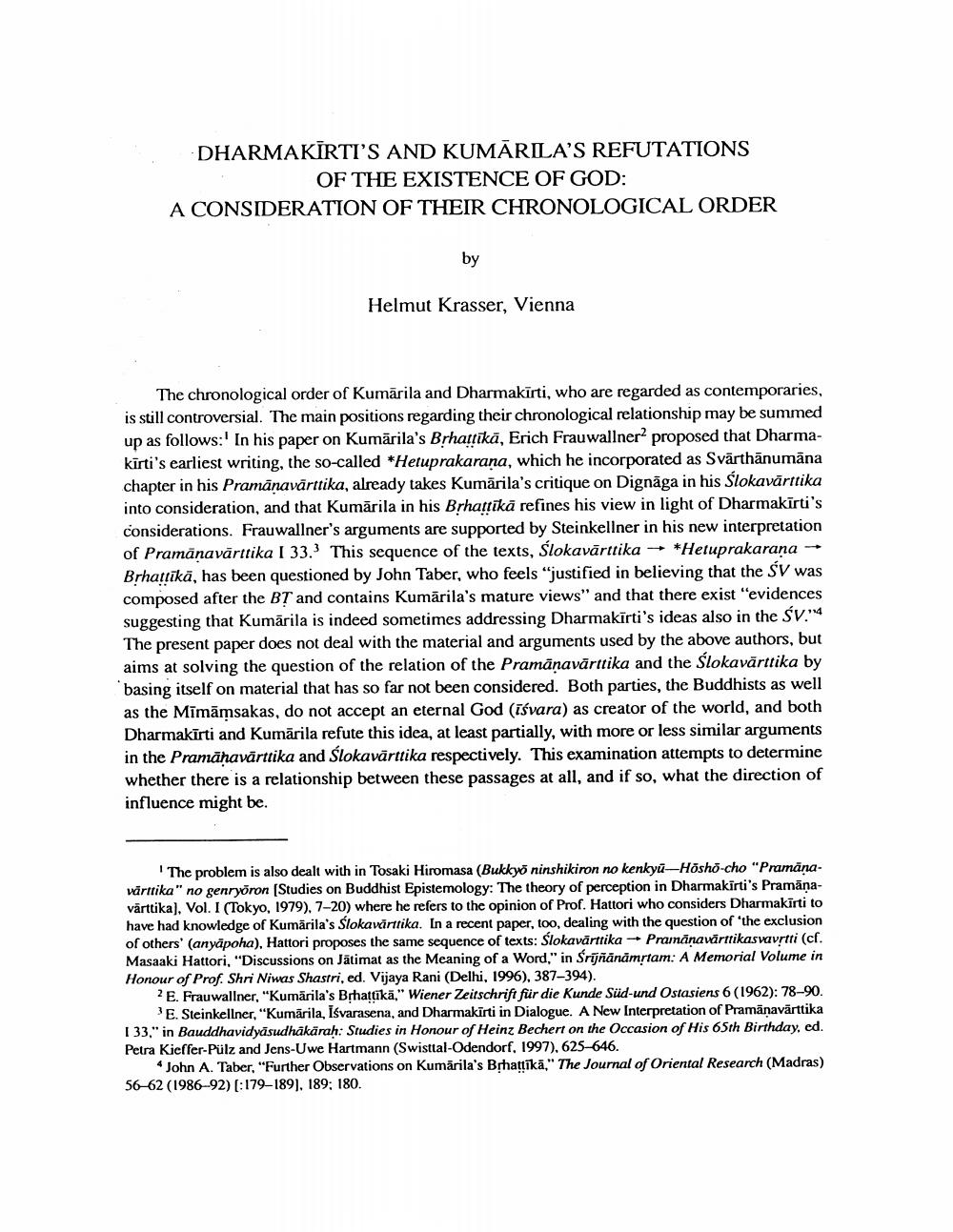________________
DHARMAKĪRTI'S AND KUMĀRLA'S REFUTATIONS
OF THE EXISTENCE OF GOD: A CONSIDERATION OF THEIR CHRONOLOGICAL ORDER
by
Helmut Krasser, Vienna
The chronological order of Kumārila and Dharmakīrti, who are regarded as contemporaries, is still controversial. The main positions regarding their chronological relationship may be summed up as follows:' In his paper on Kumārila's Brhattīkā, Erich Frauwallner proposed that Dharmakirti's earliest writing, the so-called *Hetuprakarana, which he incorporated as Svārthānumāna chapter in his Pramanavārttika, already takes Kumārila's critique on Dignāga in his Slokavārttika into consideration, and that Kumārila in his Brhattikā refines his view in light of Dharmakīrti's considerations. Frauwallner's arguments are supported by Steinkellner in his new interpretation of Pramänavärttika I 33.' This sequence of the texts, Slokavärttika - *Hetuprakarana Brhattīkā, has been questioned by John Taber, who feels "justified in believing that the SV was composed after the BȚ and contains Kumārila's mature views" and that there exist "evidences suggesting that Kumārila is indeed sometimes addressing Dharmakirti's ideas also in the ŚV.4 The present paper does not deal with the material and arguments used by the above authors, but aims at solving the question of the relation of the Pramānavārttika and the Slokavārttika by basing itself on material that has so far not been considered. Both parties, the Buddhists as well as the Mīmāmsakas, do not accept an eternal God (iśvara) as creator of the world, and both Dharmakīrti and Kumārila refute this idea, at least partially, with more or less similar arguments in the Pramānavārttika and Slokavārttika respectively. This examination attempts to determine whether there is a relationship between these passages at all, and if so, what the direction of influence might be.
The problem is also dealt with in Tosaki Hiromasa (Bukkyo ninshikiron no kenkyū—Hosho-cho "Pramanavärttika" no genryõron (Studies on Buddhist Epistemology: The theory of perception in Dharmakirti's Pramāņavārttika), Vol. I (Tokyo, 1979), 7-20) where he refers to the opinion of Prof. Hattori who considers Dharmakirti to have had knowledge of Kumärila's Slokavarttika. In a recent paper, too, dealing with the question of the exclusion of others' (anyäpoha), Hattori proposes the same sequence of texts: Slokavārttika - Pramanavārtikasvavrtti (cf. Masaaki Hattori, "Discussions on Jātimat as the Meaning of a Word," in Srijñānāmrtam: A Memorial Volume in Honour of Prof. Shri Niwas Shastri, ed. Vijaya Rani (Delhi, 1996), 387-394).
2 E. Frauwallner, "Kumārila's Brattikā," Wiener Zeitschrift für die Kunde Süd-und Ostasiens 6 (1962): 78-90.
E. Steinkellner, "Kumärila, Isvarasena, and Dharmakirti in Dialogue. A New Interpretation of Pramāņavārttika 133," in Bauddhavidyasudhakärah: Studies in Honour of Heinz Bechert on the Occasion of His 65th Birthday, ed. Petra Kieffer-Pulz and Jens-Uwe Hartmann (Swisttal-Odendorf, 1997), 625-646.
John A. Taber, "Further Observations on Kumärila's Brhattikā," The Journal of Oriental Research (Madras) 56-62 (1986-92) (:179–189). 189; 180.




